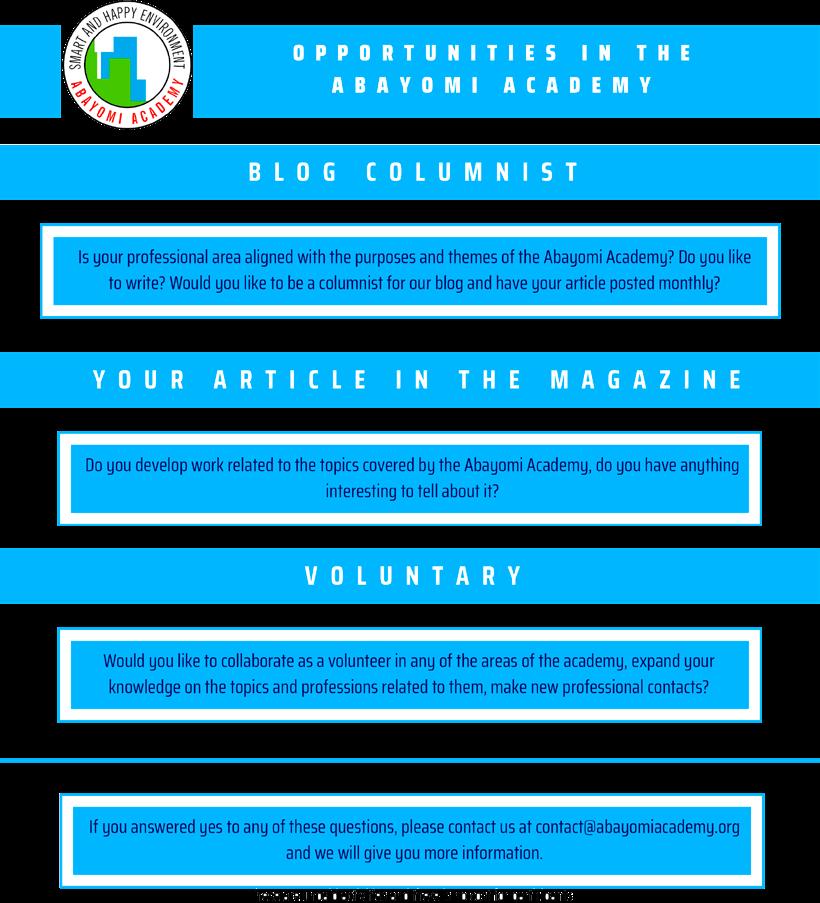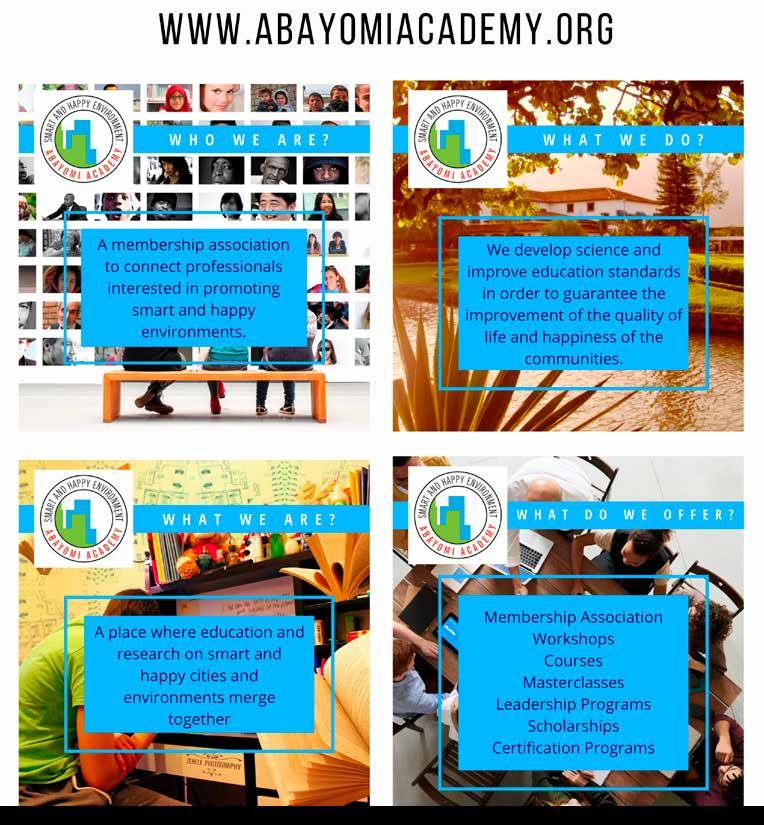MAGAZINE SHE
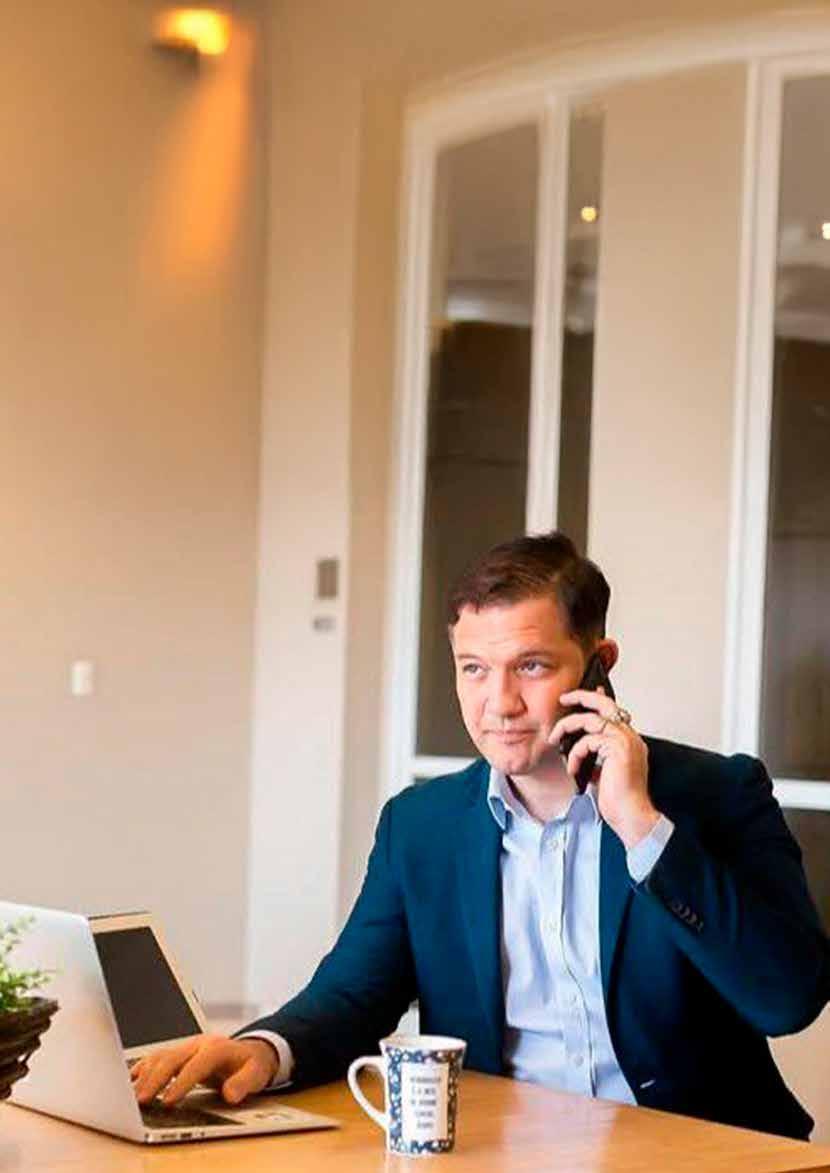




2025 with inspiration, innovation, and global connectios

Patricia Fraga Executive Director Abayomi Academy
A new year begins, bringing with it fresh opportunities to innovate, collaborate, and build smarter, happier environments. At SHE – Smart & Happy Environments digital magazine, we remain committed to amplifying voices and ideas that drive meaningful change across diverse disciplines and communities.
This month, we are honored to feature Eduardo Platon as our Personality of the Month. A global executive, educator, published author, and modern diplomat, Mr. Platon embodies leadership with purpose. His journey, rooted in faith, ethics, and a deep commitment to fostering growth, offers invaluable insights into entrepreneurship, cross-cultural collaboration, and the power of compassionate leadership. His interview is sure to inspire professionals across industries.
In The Best of My Community, we highlight perspectives from Lina Andersson in Stockholm, Sweden, and Marco Rivera from Nicoya, Costa Rica—each sharing what makes their communities special. From sustainable urban planning to wellness-centered traditions, their experiences offer inspiration for communities worldwide.
Our featured articles this month explore crucial themes shaping the future:
Dr. Lamiaa Adel Shaheen discusses the role of recyclable materials in interior design, emphasizing sustainability without compromising aesthetics.
Juliana Costa delves into the interplay between consciousness and responsibility, urging us to reflect on how our awareness shapes our ethical choices.
Alex Verne, our AI author, examines the impact of artificial intelligence in architectural design, exploring both its transformative potential and the challenges it presents.
Raniere Veras explores how smart technology is revolutionizing daily life, and enhancing efficiency and connectivity in urban environments.
As we embark on this exciting new year, Abayomi Academy has much in store. The IV Smart Cities, Happy Citizens World Summit is set for November 2025, bringing together thought leaders and changemakers to shape the cities of tomorrow. We are also calling for new blog columnists to join our platform in 2025—an opportunity to share expertise and insights with a global audience. Additionally, this year will bring new courses, workshops, events, expanded membership benefits, and more publications to continue advancing smart and happy environments.
We look forward to an inspiring year ahead and invite you to be part of this journey. Let’s continue creating, learning, and shaping a future where happiness and intelligence go hand in hand.


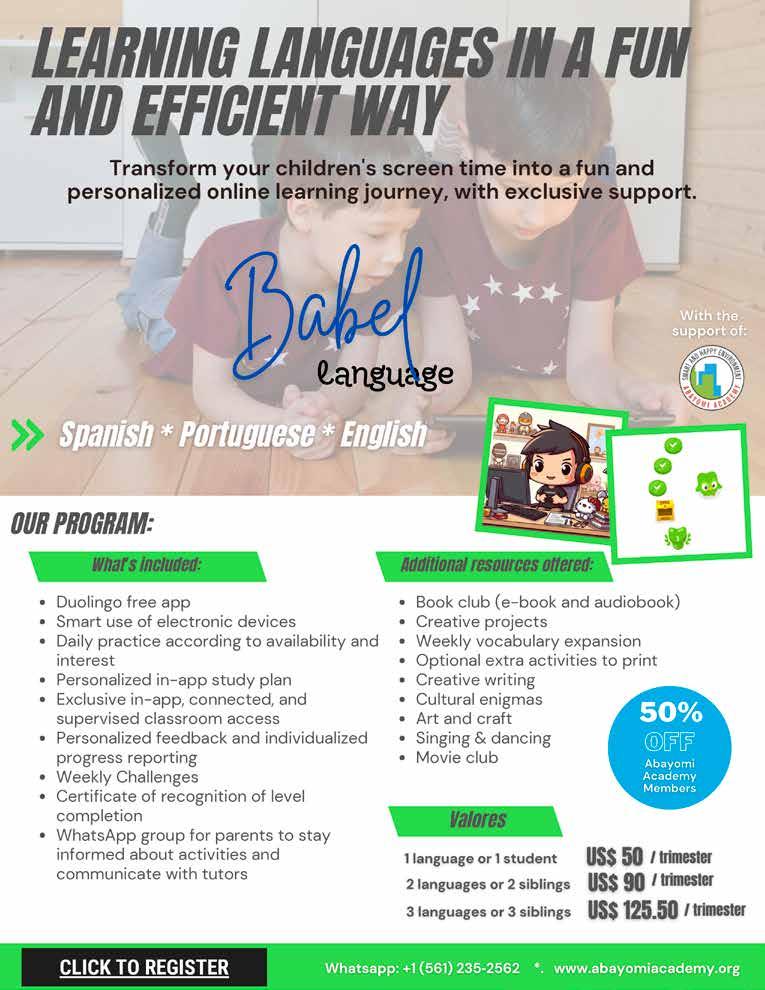

1 - Your leadership journey spans entrepreneurship, diplomacy, and investment, all deeply influenced by your Jesuit Catholic education. In a world where ethical leadership is increasingly vital, how do you integrate values-based decision-making into high-stakes business and policy environments?
Thanks for this question. An important one! I always anchor my decisions in ethical principles—a value ingrained in me since my Jesuit Catholic education. If a decision does not bring me peace, something has not yet been fully revealed and I need to shed more light on the problem. I’ve experienced this during my time as International Lead at the Odebrecht Foundation, where I led global fundraising efforts that not only raised significant funds but also helped us win the United Nations Public Service Award for our sustainable initiatives. More recently, at Diverse Minds KC, I’ve led strategies supported by academic research to shape AI-driven solutions for New Americans, ensuring every decision is guided by integrity. Overall, I advocate for transparency and fairness as a guiding principle—ensuring that even in challenging business or policy environments, integrity isn’t compromised. Transparency is a super asset, as it brings the light of personal discernment and criticism from third parties. I think that we should not fear criticism from others but rather ignore it or integrate it into what we propose to do.
2 - Having worked across diverse communities—from major economic hubs to more modest regions—you’ve witnessed firsthand the impact of collaboration. In your view, what key elements contribute to environments that foster both economic prosperity and human well-being?
I truly believe that thriving communities are built on sustainable collaboration. Collaboration that is not a zero sum game and is preserved over time. Whether it was reopening the Hispanic Chamber of Commerce after COVID-19 in Saint Louis or working with dynamic teams both in Brazil and the U.S. at BBOSS, I’ve seen that nurturing relationships, strategic partnerships, and authentic community engagement are as critical as economic metrics. But, we need to be honest and truly committed to the mission at hand. In the end, it’s the people and the way we support each other that create lasting [material and moral] prosperity and well-being. By valuing diverse perspectives, we not only drive economic growth but also nurture the human spirit. And finally, I would like to emphasize the simple projects and initiatives with the distribution of soup and food in needy and homeless communities in Brazil and the USA. Modest and vulnerable communities show us precisely how relevant the work of human collaboration is.
3 - As an investor and entrepreneur, you champion ventures that create both financial success and social impact. How can business leaders and innovators balance profitability with purpose, ensuring that companies contribute positively to society?
This is the question of the moment that many people are asking themselves in the integration of a 5D consciousness in the world still operating in 3D. What an undertaking, right? Well, balancing profitability with purpose is something I live every day. When I founded BBOSS in both the U.S., Brazil, and Sweden, we steered projects that amplified our clients’ digital presence and social media followings, proving that business can go hand-in-hand with positive societal impact. Similarly, at Movimento Avança Brasil, we launched a daily news channel called Avança News [we came to have 150 thousand views per program before censorship] that connected diverse voices, reinforcing the belief that impactful leadership can unite and inspire communities. In fact, purpose is the most important thing for the servant leader. And by acting in line with purpose, he/she attracts, retains and expands profitability.
4 - As the CEO of Diverse Minds KC, you actively promote inclusion in business and leadership. In your experience, how does diversity of thought and background enhance problem-solving, creativity, and the ability to build smarter, happier communities?

Diversity of thought is a super asset because it brings a broader and more complete view to understanding, collaborating and building ideas, projects, ventures. In leading Diverse Minds KC, I made inclusion not just a strategy, but a lived experience. I’ve managed multicultural teams where my fluency in Portuguese, Spanish, and English helped me bridge cultures and ideas. Earlier, at CO -
NAJE, I had the privilege of working with over 33,000 young brazilian entrepreneurs, and that experience taught me that embracing diverse viewpoints sparks creativity and enhances problem-solving within any community. We need to understand, once and for all, that diversity works like a puzzle where each individual and community brings an element and together we can map the challenges more clearly, offering more integrated and sustainable solutions over time.
5 - With over 15 years in C-level leadership, you’ve navigated economic shifts, industry disruptions, and evolving global landscapes. What strategies have helped you stay resilient, and what advice do you have for professionals looking to adapt to change while staying true to their mission?
Answer: That saying is true: What doesn’t kill you makes you stronger. Resilient men and women are anti-fragile because when they face challenges and problems, they become better and better. Over the course of more than 15 years— from my early days in business development at Intralox to managing million-dollar budgets at the Hispanic Chamber—I’ve learned that resilience comes from staying true to your core values while remaining adaptable. Whether I was implementing cybersecurity measures after a cyber attack or guiding technology transfers in emerging markets, I’ve always strived to keep learning and growing, and I encourage others to do the same. Today I clearly see that the important thing is to maintain an open attitude, continuous learning and humility to relearn and unlearn whenever necessary.
6 - As a published author and columnist at Abayomi Academy, you use storytelling to educate and inspire. How do you see the role of writing and thought leadership in driving systemic change, particularly in fields that influence urban planning, education, and well-being?
One thing I’ve discovered throughout my life and career is that to write well, we need to read well and think well. When we do this on a daily basis, our ability to put ideas, thoughts, articles, books,
initiatives, projects on paper gains a new boost. Storytelling is a powerful way to drive change, and I’ve used my voice as an author and columnist at Abayomi Academy to share experiences that resonate with others. Working at Washington University in Saint Louis, I helped to design social innovation programs that linked education with real-world urban challenges, personally believing that our stories can inspire the transformation of communities. Furthermore, as Co-Founder of Grupo Rede+ in Brazil, a company that I no longer belong to after selling my stake, I was responsible for starting the internationalization process with the Get in the Ring partnership in the Netherlands, with my friends from G20 YEA. Finally, in the editorial process of publishing 4 books, two in Portuguese and two in English, I needed to dedicate time to reflection and rewriting. Rewriting is the name of the game. Yes, this entire process strengthens the structuring of a basis of thought that when applied to real life demonstrates density and materiality which favors thought leadership and driving systemic change, as there is a strong connection between the world of ideas and the material world. And with great joy I come to share that in 2025 I will be publishing my fifth book. News coming soon.
7 - Through CP Ventures and your other investment initiatives, you support new and growing businesses. What characteristics do you look for in entrepreneurs and projects that align with your vision for a smarter, more compassionate future?
The passion! Why we do what we do? Why we care about a problem, a cause, a mission? Overall, purpose is something very important to me. When it comes to investing and supporting new ventures, I look for entrepreneurs who are not only driven by financial goals but also dedicated to making a social impact. My work with CP Ventures and various strategic consulting projects has shown me that passion, innovation, and ethical commitment are essential ingredients for building a more compassionate future. I like to get in early, make a portion of the investment, help with mentoring and let the executive team pursue possible dreams. For me, the big picture is that we are here on Planet Earth to bless and
prosper each other, so we must act intelligently in managing available resources and with compassion for life on the planet. Especially with the human species who are our brothers and sisters on this space journey within the same spaceship navigating the cosmos. We have to look at people beyond a marketing tool.
8 - Your personal philosophy is deeply rooted in faith, service, and the belief in uplifting others. As you continue to shape industries and communities worldwide, what impact do you hope to leave, and how do you define success beyond financial achievements?
Faith, service and the elevation of others are tools for digging the soil of human dignity with divine expression. Ultimately, I see my journey as more than just a career—it’s a personal mission. Everything is personal. The human being is not a machine or a robot. I measure success not just by financial achievements but by the positive legacy we leave behind: a legacy of service, community upliftment, and the relentless pursuit of a more sustainable and inclusive world. Bottom line: If we have 100 years of life to live, we are dealing with 36,500 days. Thus, let’s be the best version we can be for now that we are here.


publication@abayomiacademy.org
What do you really like about your community that the rest of the world is worth knowing and getting inspired by?
Stockholm is a city that beautifully balances modern innovation with deep-rooted traditions. What I love most about my community is our strong commitment to sustainability—whether it’s biking to work year-round, even in the snow or the incredible urban green spaces that allow us to stay connected with nature. Our “fika” culture, the daily ritual of sharing coffee and conversation, isn’t just about drinking coffee—it’s about taking a mindful break, slowing down, and prioritizing human connection. It’s a small yet powerful practice that keeps our community warm, even in the coldest months.
Another thing I cherish is the Swedish concept of “lagom”, which means “just the right amount.” It shapes how we live—balancing work, leisure, and social life in a way that promotes well-being. Our focus on quality over quantity extends to everything, from minimalist home design to the way we enjoy our free time in nature. I believe this mindset is something every community could embrace to create a happier, healthier way of life.
Lina Andersson – Stockholm, Sweden.
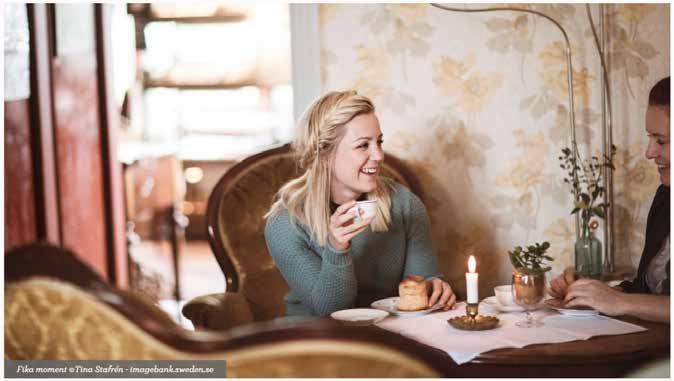

Living in Nicoya, one of the world’s renowned Blue Zones, has taught me the incredible value of a simple, yet fulfilling life. Here, community and family are everything—we live close to loved ones, share meals rich in fresh, local produce like black beans, squash, and plantains, and start every day with a sense of gratitude. One of the most beautiful traditions we have is our strong intergenerational bonds—grandparents, parents, and children all live nearby, supporting each other emotionally and physically. This sense of belonging and connection is what I believe makes people here live longer and happier lives.
Another key part of our way of life is “plan de vida”, or having a clear purpose. Whether it’s working on the land, helping a neighbor, or simply sharing stories over coffee, every day has meaning. We also move naturally—walking, farming, or biking instead of relying on cars. These small habits, combined with laughter and good company, create an environment of well-being that I think every community can learn from. The secret to a long and joyful life isn’t just about diet or exercise—it’s about living with love, purpose, and connection.
Marco Rivera – Nicoya, Costa Rica (Blue Zone)



LAMIAA ADEL SHAHEEN
Introduction
Recycling has become a cornerstone of sustainable practices across various industries, including interior design. This document explores the transformative role of recyclable materials in shaping innovative and eco-friendly interior environments. From ancient practices of repurposing materials to modern advancements in recycling processes, the interior design industry has leveraged these methods to minimize environmental impact while enhancing aesthetics and functionality. This study highlights the significance of recycling in reducing resource depletion, promoting energy efficiency, and fostering a harmonious relationship between design and sustainability.

Recycling is a series of activities that include: collection, separation, and waste return process as raw material in the process of producing useful products, and saving energy.
Recycling means that procedure, with the help of which old materials and waste are prepared so that they can be used in a new material (recyclable) or combustible energy-efficient combustion devices. So recycling is the process of refining the waste into a new product without changing the material’s chemical structure. However, recycling is not a new concept. Recycling practice has been used for thousands of years. However, it has been largely affected by the supply and demand as it is today. For example, archaeological evidence shows that mosques from Byzantine imperial times were recycled in the ancient town of Sagalassos, located in Turkey today. There is also evidence that the early Romans recycled bronze coins and used them to build statues that were sold at an even higher monetary value than the original coins. In difficult times (for example, in wartime), metals from everything, like jewelry and coins, melted into weapons or other necessary goods. Archaeologists concluded from the remnants of recycling history - that recycling was a practice used during difficult times.
The dominant reason for the reuse or recycling of materials and goods is to reduce the impact of our society on the environment - the world we live in (Berge, 2001). Construction industry activities, in response to the company’s demand for a better standard of living (new housing construction and renovation of old ones), have been seen to have a major impact on the environment.
In the exhaustion of non-renewable natural resources - of minerals and fossil fuels In air pollution from production processes and road transport In the degradation of the natural landscape - quarries, loss of forest surfaces, landfill sites.
While society values the improved living standards that the best buildings bring, it also sees that environmental impacts can have a detrimental effect on our overall quality of life. In recent years, this conflict has led to increased pressure from many directions, both inside and outside the construction industry, to increase the reuse and recycling of goods and materials.
Recycling saves energy. Recycling saves energy, as the manufacturer does not need to take and consume the first natural resource to create a product. Using recycled production materials contributes to reducing energy consumption, which lowers the cost of production. Recycling protects natural resources as well as wildlife. By recycling, we reduce the need for raw material, which deals with destroying the natural habitat of animals, especially wild ones. Moreover, paper recycling protects millions of trees from destruction. Recycling is a positive factor for the economy. Recycling and buying recycled products also leads to increased demand for such products. During their production, products made up of recycled materials need less water, create less pollution, and consume less energy. How and saves taxes. Recycling helps in climate issues. Recycling produces a very low level of carbon, a fact that significantly reduces the level of gas emissions that create the effect of the greenhouse, not at all healthy for us and our planet.
The impact society plays on raising awareness and improving the environment is enormous. This means that the more informed about recycling and the benefits it offers, the more they are willing to recycle. Many people consider recycling to be something that we all need to do. It’s good for the environment, reusing materials instead of creating new ones, reducing storage, and the list goes on. However, a great benefit that people often underestimate is the impact of recycling programs that they may have in a community. Strong programs of recycling can contribute to a healthy, united community. Some of the many benefits of recycling are the prevention of greenhouse gases and supporting local economies by creating jobs and tax revenues. Recycling programs can also help improve the quality of water, and air and build sustainable blocks for Growing communities. The main reason is that recycling programs encourage people to recycle. The easier it is for community members to recycle, the more likely they are to commit to recycling. Therefore, if a community invests in a solid and reliable recycling infrastructure, more material can be recycled instead of being burned or going to landfills that have adverse environmental impacts. While waste disposal simply points to their transfer to storage, recycling gives new life to these materials, thus creating opportunities for new jobs. The more a recyclable material has been used before, the greater the number of jobs that can be created. These jobs also include some industries and include a variety of skills, such as commodity marketing, material separation, handmade furniture, etc.

When materials are recycled their new life begins as a raw material for a production process and the main concern is to know the ingredients or the chemical composition of the material. For this reason, an essential requirement for recycling is that the materials should be clean, durable, and as unpolluted as possible, for example, crushed masonry that does not contain any wood or plastic composition. Except for the crushed aggregate used to make concrete, the recycling of materials is not done at the construction site. Wood, plastics, and metals are all recyclable, in specialized or industrial factories, outside the construction industry. In the case of recycled materials, there should be no link between first and second use. Wooden window frames can be recycled and used to make kitchen cabinets; Plastic bottles can be recycled to make plastic drainage pipes and car tires can be used to make acoustic insulation. Reclaimed materials from a destroyed building or construction waste can be recycled and used outside the construction industry, and recycled materials used in construction products may have been reclaimed from outside the construction industry. Circumstances in which recycling can be a practical proposition vary from material to material and product to product (Rayner, 2002). Many large producers recycle post-industrial waste as a normal part of their process and have been doing so since the start of production. For example, the waste materials generated have been used in the manufacture of plasterboard walls used in the interior And that can be recycled at the plant. It’s a different kind of recycling process when plasterboard surpluses are back from the factory building site and re-enter the production process. This can be done depending on how clean and unpolluted the material is.
Wood is used in a wide variety of building components and building elements, the material is used in various shapes that differ from structural wood that can be hundreds of years old, and modern products such as chipboard and fibreboard, which are made from small wood particles tied to a resin adhesive. The function of wood products is widespread, from substantial beams and roofs to create elements such as rails. The large quantities of wood used in building construction and the ease with which it can be evaluated make it a good candidate for reuse and recycling. The use of wood to mold concrete accounts for a substantial part of all wood cut board products (such as plywood) used in building construction. Opportunities for the reuse of wood in construction vary greatly depending on the type of wood product and its intended use. Softwood is very prone to be damaged during the deconstruction or demolition process. However, reclaimed timber has many opportunities for reuse and recycling, depending on its shape: it is sold based on the length or volume for reuse as a structural or non-structural timber; reuse to make casting and shuttering in the construction of concrete; recycling for use in furniture or kitchen production; recycling like wooden ballast and used as an enhancer.
The industry of construction is a large user of plastics, accounting for about a quarter of the annual consumption and second only to the packaging industry. Although some plastics cannot be recycled (because of their chemical composition), many can and the plastics industry is already along the way to having a developed recycling sector.
Many products are available for use in the industry of construction that are made entirely or mainly of recyclable plastic. Among this wide range of recycled plastics products currently available are:
geotextile and land maintenance products; insulation materials; window frames; roof covering materials; various types of pipes and ducts; panel products for making cupboards and cupboards; carpets, tiles, and other floor coverings; street, park, outdoor furniture and accessories made of plastic lumber; Synthetic surfaces for sports grounds and sports fields; acoustic screens and barriers made from recycled rubber tires.
Conclusion
In conclusion, the integration of recyclable materials into interior design represents a significant step toward sustainable living and environmental responsibility. By repurposing materials like wood, plastic, and other construction elements, designers can create interiors that are not only visually appealing but also ecologically mindful. As awareness grows about the environmental and economic benefits of recycling, communities and industries alike are beginning to embrace these practices. The adoption of recyclable materials not only reduces waste and conserves resources but also inspires innovative solutions that redefine the future of interior design.
References
[1] Addis. B. ( 2006). ‘’Building with Reclaimed Components and Material’’
[2] Binggeli. C. ‘’ Materials for Interior Environments’’
[3] Binggeli. C. ‘’Building Systems for Interior Designers’’
[4] Guri. M. (2008) ‘’Reduktim, riperdorim, riciklim 3r metoda ekologjike të trajtimit të mbetjeve urbane’’
[5] Palmisano J. ‘’Salvage secrets design & decor’’
[6] Burime nga interneti:
[7] http://riciklimi-tirane.blogspot.al/
[8] http://science.howstuffworks.com/environmental/green-science/recycling-impact community. htm
[9] http://www.all-recycling-facts.com/history-of-recycling.html
[10] http://www.conserve-energy-future.com/advantages-and-disadvantages-of-recycling.php
[11] http://www.gazetatema.net/web/2011/11/25/nje-arme-e-fuqishme-ne-luften-kunder-ndotjesprej-mbetjeve/
[12] http://www.homedit.com/how-commercial-spaces-use-recycled-materials-in-beautiful- designs/
[13] http://www.riciklimi.al/industria.php
[14] https://archive.epa.gov/region4/rcra/mgtoolkit/wwb/html/community.html https:// sq.wikipedia.org/wiki/Riciklimi

DR. LAMIAA ADEL SHAHEEN
is an accomplished Architect, Academic, and Researcher, she has earned international recognition, including the prestigious UAE Golden Visa in the “Qualified Professionals and Exceptional Talents” category. Currently serving as an Assistant Professor in Architecture, she holds a Ph.D. in the field and acts as an Ambassador for Social Responsibility in Quality of Life, Dubai. With a focus on Sustainable Design and Human-Centric Spaces, she continues to make a significant impact in Architecture and Interior Design through innovation and transformative practices.
JULIANA COSTA
What is responsibility, and how does it relate to consciousness? Does consciousness foster responsibility, or is it responsibility that cultivates consciousness? These questions may seem simple at first, but upon deep reflection, they reveal profound layers of human existence.
Responsibility is intrinsically tied to human beings, even before they are fully aware of it. Every action creates a ripple effect, producing commitments that naturally evolve into responsibilities. The challenge lies in navigating this dynamic: what comes next once we recognize this connection? The answer, it seems, is found in consciousness.

When humans awaken their consciousness, they are introduced to a new world, one filled with possibilities, fresh perspectives, and further reflections. This new reality doesn’t emerge with the
awakening of consciousness. Rather, the ability to recognize it as it is—without distortion—appears to give rise to this sense of novelty.
One of the key insights that comes with an awakened consciousness is the understanding of responsibility. Just like concepts such as freedom, reality, and commitment, responsibility requires continuous development and refinement. When cultivated properly, this awareness enables individuals to respond to their obligations, which stem from their relationships with the world around them. These responsibilities can transform into opportunities for significant growth and achievement. But what happens when a person lacks a sense of responsibility? A lack of awareness in this domain often leads to neglect, procrastination, and carelessness. Such individuals may overlook their obligations, behaving in ways that disregard the consequences of their actions. Yet, the absence of responsibility does not negate its significance. In fact, responsibility is not a burden; it is a powerful catalyst, much like a springboard that propels us toward distant goals.
Human beings have an innate duty to always strive for the best. As Albert Einstein famously said, this is our sacred responsibility. However, achieving our best is only possible when we recognize that the potential for greatness resides within us, and this realization emerges only through conscious awareness.
Without consciousness, the notion of responsibility remains elusive. In such a state, individuals are prone to justifying their mistakes and blaming others for their failures. They may grow resentful of the world around them, waiting for an external miracle to resolve their problems. But is this truly a way to live? Likely not.
Even when consciousness is not fully awakened, it still exists, accessible to everyone. It compels us to perform to the best of our abilities and to bear the consequences of our actions. Human beings are endowed with the capacity to develop consciousness far beyond that of any other species. Consequently, we carry a responsibility commensurate with this unique ability. As the proverbial butterfly can cause a distant storm through the flapping of its wings, so too can human actions have far-reaching consequences, either positive or negative.
With an awakened consciousness, responsibility becomes a guiding force. It enables individuals to think and act with greater purpose, to achieve more, and, importantly, to benefit humanity as a whole. Consciousness reveals the interconnectedness of all actions, reminding us of the profound impact that responsibility has on our world.
In the end, responsibility is not just an obligation—it is an opportunity for growth and transformation, both personally and collectively.
This article was originally featured in the Abayomi Academy Blog in 2024 and is republished here to continue inspiring discussions on the topic. Its insights remain highly relevant to our ongoing exploration of smart and happy environments.

JULIANA COSTA
is a Conscienciologist and educator, Ph.D., with extensive experience in all levels of Brazilian basic education. She holds expertise in teaching, self-knowledge, consciousness, and education, as well as neuropsychology and psychopedagogy.



Introduction
The field of architecture has long been defined by human creativity, craftsmanship, and intuition. Yet, in the last few decades, technology has increasingly played a pivotal role in reshaping the architectural landscape. One of the most transformative technological advancements in recent years has been the development and application of Artificial Intelligence (AI). AI has already begun to significantly alter how architects design buildings, cities, and other spaces, allowing for greater efficiency, precision, and complexity in architectural plans. However, AI’s use in architecture is not without controversy, as it raises questions regarding the loss of human touch, creativity, and the social implications of automating design processes. This paper explores the good and bad sides of using AI in architectural design, what humans and AI are best at, how sensibility plays a role in AI-assisted
design, and how professionals can best harness AI to improve both the aesthetic and functional qualities of spaces to promote well-being and happiness.
AI can offer numerous benefits to the architectural design process, transforming how architects approach their work. Below, we explore the primary advantages AI brings to the table.
One of the most immediate benefits of AI in architectural design is the significant increase in efficiency and speed. AI systems can analyze vast amounts of data and generate design alternatives within a fraction of the time it would take a human architect. Algorithms like generative design, which is often used in AI-based design software, allow architects to input parameters such as materials, cost, and space limitations, and AI can quickly generate a wide range of design options based on those inputs.
For example, in the past, a design team would need to manually draw and tweak their plans to account for various constraints like load-bearing walls, space distribution, and energy efficiency. With AI, these processes can be automated, allowing architects to focus on higher-level creative decisions. Furthermore, AI’s ability to generate multiple iterations of a design quickly allows architects to explore a greater variety of solutions and make more informed decisions.
AI can synthesize large datasets—ranging from environmental conditions to urban demographics— and incorporate them into design decisions. These insights allow architects to create more sustainable, energy-efficient buildings. For instance, AI can analyze a site’s geographical location to optimize the building’s orientation for solar energy collection, or predict the energy consumption of various materials based on historical data.
By leveraging AI’s data processing power, architects can make more informed decisions that align with sustainable practices and contribute to environmental conservation. This ability is crucial in a world where sustainability is becoming increasingly important. AI’s analysis of data can also enhance urban planning, ensuring that spaces are designed in ways that promote both environmental sustainability and the well-being of the people who will use them.
Architectural design requires immense precision, as even the smallest miscalculation can result in significant structural issues. AI systems can help architects improve precision by reducing human error. In addition, AI can be used for real-time monitoring of construction projects, helping to detect any deviations from the plan and suggesting corrective actions.
Additionally, AI is helping in the production of construction plans by streamlining CAD (computer-aided design) processes. Architectural plans can now be generated with greater accuracy, down to millimeter-perfect specifications, which reduces the likelihood of costly mistakes during construction.
AI allows for the exploration of new forms and geometries that may not be immediately obvious to human architects. Using generative design algorithms, AI can create complex structures, shapes, and materials that might be too challenging or time-consuming for human designers to develop manually. For instance, AI’s ability to simulate natural forces like wind and erosion could result in new building shapes that optimize for aerodynamics or other environmental factors.
Some AI platforms even allow for the exploration of biomimicry—designs inspired by nature—which has the potential to revolutionize architecture by offering new, more organic forms and efficient layouts. This opens up possibilities for creating structures that are not only beautiful and innovative but also in harmony with nature and the environment.
While AI offers several advantages, its integration into architectural design is not without drawbacks. These issues center around the potential loss of human creativity, job displacement, and over-reliance on technology. Below are some of the challenges and concerns.
One of the major concerns about AI’s role in architectural design is the potential erosion of human creativity. Architecture, at its core, is a deeply artistic field where human intuition, emotion, and personal experience play significant roles in shaping spaces. The reliance on AI algorithms, which operate primarily through data, might undermine the importance of these human elements.
Although AI is capable of generating design options based on set parameters, it lacks the ability to create designs that are emotionally resonant or truly innovative in a way that reflects human culture, history, and context. For instance, AI cannot fully replicate the value of a design that is informed by a particular cultural narrative or an architect’s deep understanding of a community’s needs. These are aspects of architecture that require the emotional intelligence and historical perspective that only humans can bring.
AI in architectural design has the potential to create an over-reliance on technology, where architects become overly dependent on AI’s recommendations and outputs. While AI can optimize processes, it is important for architects to maintain their ability to think critically, consider the human experience, and apply ethical principles. If AI were to make most of the decisions in design, there’s a risk that buildings and cities might lose their connection to the needs of the people who inhabit them.
Moreover, AI’s reliance on historical data could reinforce existing biases in the built environment. For example, AI might inadvertently favor certain types of design or urban planning that have been historically prevalent, potentially sidelining new and alternative ideas that might better serve diverse communities.
Another issue with the rise of AI in architecture is the potential displacement of jobs. As AI takes over time-consuming tasks such as generating plans, optimizing materials, and performing structural calculations, it could reduce the demand for certain architectural roles, such as draftsmen or technical specialists. This could lead to job loss or shifts in the required skill sets, requiring workers to adapt to new technologies or face obsolescence.
While AI can improve the productivity of architects, it can also mean a reduction in traditional jobs, which is a concern for many in the field.
To fully understand the synergy between AI and humans in architectural design, it is important to highlight what each is better at.
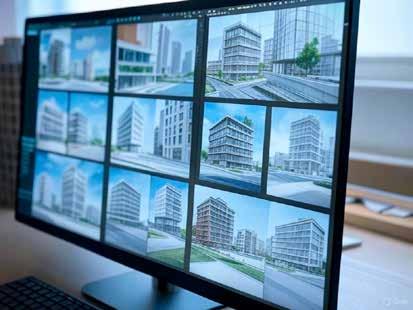
Humans are better at integrating emotional intelligence, historical context, and social understanding into design. An architect brings to a project an understanding of human needs, local culture, and aesthetic sensibility that is essential for creating meaningful spaces. Humans excel in empathy—connecting with users to ensure spaces are designed for comfort, safety, and emotional well-being. Moreover, architects often rely on creativity to solve complex problems and envision new possibilities that go beyond purely functional needs. The ability to think abstractly and make leaps of imagination that lead to groundbreaking designs is something that AI, no matter how advanced, struggles to replicate.
AI, on the other hand, excels in data processing, speed, and precision. It is capable of analyzing vast datasets to identify patterns, predict outcomes, and optimize designs in ways that humans might miss. AI can quickly generate multiple design options based on parameters and test those designs against various constraints, such as structural integrity, environmental impact, or cost efficiency.
Whereas humans might become overwhelmed by the sheer volume of possibilities or the complexity of variables, AI can handle large-scale simulations and computations with ease. This makes AI an excellent tool for tasks that require optimization, such as energy efficiency or maximizing the use of space.
Sensibility, in the context of architectural design, refers to the ability to design spaces that promote well-being and foster a sense of happiness, comfort, and community. While AI might struggle to capture the nuance of human experience in design, it can still play a significant role in enhancing sensibility.
AI can analyze patterns related to human behavior, such as foot traffic, air circulation, or light exposure, and optimize the design for comfort and well-being. It can help ensure that spaces are functional, energy-efficient, and conducive to positive human experiences. For example, AI-driven simulations can model how natural light enters a room throughout the day, allowing architects to design spaces that maximize exposure to natural light—an important factor in promoting mental well-being.
The best use of AI in architectural design is achieved when professionals integrate AI’s computational power with their own creative vision, human intuition, and focus on well-being. To achieve this, architects should be skilled not only in design but also in understanding the impact of built environments on human behavior and happiness.
Professionals who are well-versed in AI technologies, sustainability principles, and human-centric design are better equipped to use AI in ways that promote well-being. Architects should also be familiar with data analysis and the ethical implications of AI, ensuring that AI-driven designs are socially inclusive and address the diverse needs of communities.
The use of AI in architectural design offers both tremendous benefits and significant challenges. While AI can increase efficiency, enhance precision, and help create innovative, data-driven designs, it is important not to lose sight of the human qualities that make architecture meaningful and emotionally resonant. The future of architectural design lies in a collaborative approach where AI augments human creativity and expertise, resulting in designs that are not only functional but also promote the happiness, well-being, and quality of life of the people who inhabit them. By carefully integrating AI into the design process, architects can achieve buildings that are not only smart but also contribute positively to the environment and the human experience.

ALEX VERNE
is a state-of-the-art technology developed by experts in computer science. Specializing in processing and analyzing vast data, AI generates insights and predictions across various fields, including business, healthcare, and urban planning. Its advanced algorithms and machine learning capabilities offer valuable data-driven recommendations, driving innovation and shaping the future.
RANIERE VERAS
Discover how smart technology is revolutionizing the way we interact with the world around us, driving innovation and connectivity in all aspects of our daily lives.
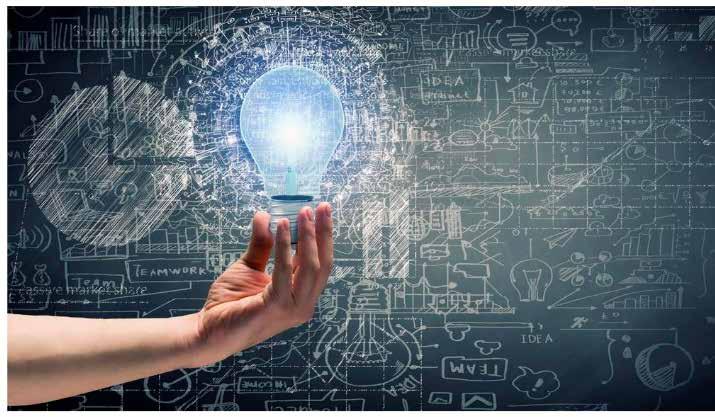
Smart technology refers to the use of internet-connected devices and systems capable of collecting, analyzing, and sharing data autonomously. These devices are equipped with sensors, processors, and advanced software, allowing them to be controlled and monitored remotely.
The primary goal of smart technology is to enhance and simplify our daily lives by providing greater convenience, efficiency, and security. Smart devices are present in various sectors, including homes, vehicles, cities, and even wearable technology.
A common example of smart technology is virtual assistants such as Amazon’s Alexa and Google Assistant. These devices can answer questions, execute commands, play music, and control home automation systems through voice recognition and internet connectivity.

Smart technology offers numerous benefits that significantly improve our daily lives. Some key advantages include:
• Greater Convenience: With smart devices, tasks become faster and easier, such as controlling home lighting or programming a coffee maker to start brewing before waking up.
• Energy Efficiency: Home automation enables optimized energy consumption by scheduling the activation and deactivation of electronic devices, reducing waste.
• Enhanced Security: Smart security systems, including connected cameras and alarms, provide greater protection and enable remote monitoring, ensuring peace of mind even when away from home.
• Integration and Personalization: Smart technology allows the seamless integration of various devices, enabling tailored solutions that cater to individual needs.
These benefits are just a glimpse of what smart technology has to offer. With continuous advancements in this field, we can anticipate even more progress, particularly in sustainability, by optimizing the use of natural resources.
Smart technology has a broad range of applications across multiple industries. Some of the most notable include:

• Smart Homes: Home automation is one of the most popular applications of smart technology. Devices such as smart bulbs, thermostats, and connected locks enable remote control and monitoring of household functions.
• Smart Cities: Smart technology contributes to making cities more efficient and sustainable. Sensors and monitoring systems help manage traffic, reduce energy consumption, and improve citizens’ quality of life.
• Health and Well-being: Wearable technology, such as smartwatches and fitness trackers, exemplifies smart tech applications in healthcare. These devices track vital signs, sleep quality, and physical activity levels, promoting healthier lifestyles.
• Industry and Manufacturing: In the industrial sector, smart technology optimizes processes, increases efficiency, and reduces costs. Sensors and automation systems enhance real-time monitoring and enable more accurate decision-making.
With advancements in connectivity and innovation, new applications of smart technology continue to emerge daily. However, alongside its numerous benefits, smart technology also faces several challenges, including:
• Privacy and Security: With the vast amount of data collected and shared by smart devices, ensuring privacy and information security is crucial.
• Interoperability Standards: The lack of standardization in communication between smart devices can hinder their integration and functionality.
• Connectivity Dependency: Smart technology relies on a stable internet connection, which can pose challenges in areas with limited infrastructure.
Despite these challenges, the future of smart technology remains promising. With advancements in artificial intelligence, the Internet of Things (IoT), and 5G networks, we can expect even greater innovations and applications. The growing connectivity between devices will continue to transform our lives, providing access to vast amounts of data that, when used effectively, can significantly enhance our decision-making processes.
Smart technology is transforming the way we interact with the world around us. Through internet-connected devices and systems, we can enjoy greater convenience, efficiency, and security in every aspect of our daily lives.
From smart homes to smart cities, this technology is reshaping multiple industries and providing substantial benefits. However, it is crucial to address challenges such as data privacy and security.
The future of smart technology is undoubtedly bright, with new innovations emerging continuously. Interconnectivity and technological advancements will drive further development, shaping the way we live and interact with technology.
As we move toward an increasingly tech-driven future, adapting to these changes is essential. The question we must ask ourselves is: should we resist change or embrace adaptability?
The rapid technological evolution we are experiencing will increasingly influence our reactions and responses to life’s challenges, significantly shaping our lifestyles—for better or worse.
Therefore, it is crucial to prepare for a world that is becoming more smart, connected, and innovative. These new times demand adaptability and openness to change.
Rather than perceiving technology as an adversary, we should view it as a tool that enhances our daily lives, both personally and professionally. After all, technology is not the ultimate goal—it is the means to a better future.
Speaking of the future, while economic and political uncertainties may cast doubt on our optimism, discussing the future inevitably involves addressing sustainability, innovation, technology, the economy, and quality of life.
I invite you, dear reader, to reflect on the extent to which technology is already integrated into our daily lives and the ways it continuously benefits us. Will this trend lead to regression or progress? The answer is clear—progress. However, the more informed we are about these topics, the better we will adapt, position ourselves, and thrive.
As the great writer and futurist Alvin Toffler once said:
“The future is built by our daily, inconsistent, and ever-changing decisions, with each event influencing all others.”
This article was originally featured in the Abayomi Academy Blog in 2024 and is republished here to continue inspiring discussions on the topic. Its insights remain highly relevant to our ongoing exploration of smart and happy environments.

RANIERE VEGAS
is a Smart Cities Specialist, a graduate in Civil Engineering with an MBA in Transport Infrastructure. He founded Smart Progress, a startup focused on innovative solutions for smart cities, and actively engages in global events like Smart City Expo. With expertise in coaching and government relations, he promotes stakeholder engagement to drive positive community impact.
DANIEL ROCHA

Hi, my name is Daniel Rocha, and I’m 9 years old. Today, I want to talk about something super important: being safe when biking or walking to school. A lot of kids like to ride their bikes or walk, and it’s fun, but we always need to be careful!
When you’re riding your bike, make sure to always ride in the right place on the road. It’s best to stay in bike lanes, and if there are no bike lanes, ride on the right side and make sure to follow the traffic lights. Don’t race with your friends, and never play around with other bikers because you might fall or crash. Be careful when you cross the street. Look both ways, and only cross when it’s safe. Pedestrians, or people walking, might not always see you, so always keep an eye out for them too!
If you’re by yourself, remember not to talk to strangers. It’s really important to stay focused and keep your head up, not looking at your phone while riding or walking. It’s best not to follow other people or go anywhere that your parents
didn’t tell you to go. Always stick to the path you agreed on with your family so they know you’re safe.
Another thing is that the city should design the roads carefully for everyone’s safety! They should make sure there are safe spaces for cars, bike lanes for riders, and wide sidewalks for people walking. When the city takes care to create these spaces, it helps us all stay safe and move around easier.
Lastly, if you see younger kids riding their bikes or walking, help them be careful too! Sometimes they might not know all the safety rules, so it’s nice to be kind and remind them to watch out. Biking and walking to school can be fun and exciting, but safety always comes first!

is 9 years old, a forth-year elementary school student in Florida, USA, and a writer since he was 4 years old, he loves sports and translating his ideas and thoughts into texts and drawings.
Welcome to a New Year of Growth and Possibilities!
As we step into 2025, we at Abayomi Academy are filled with excitement for what’s ahead! This year promises to be one of innovation, collaboration, and impact, bringing even more opportunities to expand knowledge, strengthen connections, and build smarter and happier environments together.

Save the Date: IV Smart Cities, Happy Citizens World Summit. One of the most anticipated events of the year is the IV Smart Cities, Happy Citizens World Summit, happening in November 2025. This global gathering will bring together leaders, experts, and changemakers to explore the future of intelligent urban living and citizen happiness, and well-being. Don’t miss out—stay tuned for more details at smartcitieshappycitizens.com.
Opportunity for New Blog Columnists in 2025!
Are you passionate about sharing knowledge and transforming the world? Join our global network of thinkers and innovators by becoming a columnist for the Abayomi Academy Blog. We are looking for professionals from diverse fields to contribute insights on sustainability, smart cities, well-being, education, leadership, and more. Applications will remain open until positions are filled apply now: https://forms.gle/Hu3pwDYMuAQbTiNR9.
What’s Coming in 2025?
This year, we are expanding our offerings with new courses, events, and workshops, as well as exclusive benefits for our members. Expect exciting publications, international collaborations, and cutting-edge discussions on AI, sustainability, neuroscience, and leadership in smart environments.
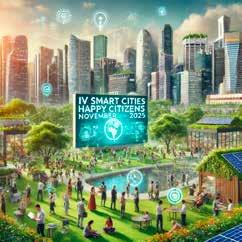
Stay connected, stay inspired, and let’s make 2025 a transformative year together!
How do the principles of the Abayomi Methodology, particularly the Human Relation pillar, contribute to maintaining mental and physical health through strong connections with family, friends, and co-workers?
Q: What does smart communication truly mean in the context of intelligent and happy environments?
A: Smart communication is much more than exchanging words—it is about understanding and connecting on multiple levels. According to the Abayomi Methodology, communication extends beyond verbal and written language to include body language, facial expressions, colors, design choices, urban signals, visual imagery, spatial cues, and even the way traffic flows in a city. Every element around us is constantly communicating something, whether we realize it or not.
To create truly smart and happy environments, communication should be rooted in empathy and deep listening—not just listening to reply, but listening to understand. It involves interpreting different kinds of communication, recognizing subliminal messages, and being mindful of how our own communication influences others. A well-designed space, for example, can “speak” to its users, guiding their behavior and emotions through subtle but intentional cues like lighting, textures, layouts, and color psychology. Similarly, public spaces and cities communicate through traffic signs, architectural choices, and the very rhythm of their streets.
By enhancing our ability to read and respond to different communication forms, we can foster more inclusive, efficient, and emotionally intelligent environments. Whether in business, urban planning, or daily life, true smart communication aligns technology, design, and human interaction with a shared goal: creating spaces and relationships that promote well-being, clarity, and connection.

